Flir E6 Thermal Infrared Camera

For as long as I’ve been aware of thermal cameras I have wanted one. In addition to being a really cool piece of technology it is uber useful. In my work at TechwareLabs.com we review a LOT of hardware, pretty much anything that uses electricity. That means heat, and at times quite a bit of it. Wouldn’t it be handy to see the heat that any given object puts off? You could isolate sources of heat and cold, find out if one part is hotter than another and get its exact temperature within 0.06 degrees C. For the more analytical among us it would be cool to see if those larger heatpipes actually convey more heat no pun intended. Introducing the E6 from Flir, a Thermal Imager for your needs.
Every now and then the tech god grants my wish and we get something really special here at TechwareLabs. Today we have a first look at the E6 from Flir. Far from a toy or random gadget this is one serious piece of hardware, and it rings in at $2,495. Get your wallets ready guys, you are going to want this in your hardware armory real soon. But first a brief history to put this into perspective.
Thermal imagers have been around for a long time. They were never what anyone except the rich would call affordable. Sporting price tags in the tens of thousands the original thermal imagers were large, had a poor battery life, and did little more than show fuzzy outlines of heat in red and blues and at a very low resolution. Large corporations and businesses purchased them for building, electrical, mechanical, and industrial analysis. Their use was a speciality and few organizations owned more than one or two due to the cost.
Fast forward to today and the story hasn’t changed much but still we have improvements. Thermal imagers are not widespread nor considered an item that most would buy. Businesses are still the primary consumers but they are gaining ground in scientific applications. The thermal sensors have improved in accuracy and efficiency leading to longer battery life and slightly better resolutions. Technology has also been develeoped that allows for the combination of thermal and standard digital images for a much clearer picture of what is being represented. Flir calls this MSX or Multi Spectral Dynamic Imaging and we will get into that later. The best development of all is that the technology has been refined to the point that the price has come down enough to make these imagers more widely available. You can now find some basic thermal imagers in the sub $1000 range. While the features and resolution on these “cheap” thermal cameras is not nearly as robust as their higher end brethren they do allow people access to a tool that was previously inaccessible.
Please watch our short first look at the E6 from Flir.

Specifications and Details
So here is a quick look at the specifications behind Flir’s new EX series lineup. The model we have here today, the E6 is second from the top and shares all of the features except resolution in common with the E8 which has twice the price tag.
The lineup is essentially broken into two groups, the E4 and E5 and the E6 and E8. Physically the units appear identical on the outside. All come with a 3 inch 320×240 display and identical controls as well as battery and micro USB port for charging and data transfer. Inside is where things get interesting. While the E6 and E8 share the same characteristics save resolution, there are even further differences between the E4 and E5. At the low end the E4 starts off with a $995 price and 80×60 resolution. Its sensitivity is good but not as good as the E5 and less than half as sensitive as the E6 and E8. Differnces at these scales being minute but for analysis and science work the E4 may not be good enough.
Digging a bit further the feature set on the E6 and E8 is enhanced with additional options like picture in picture, Alarm, and Isotherm. You will have to weigh the benefit of these features to your needs and if they are worth the further outlay of cash. We opted for the E6 which gives us all the benefits of the E8 but at a 50% reduced cost and 50% reduced resolution. Our E6 unit comes with a 160 x 120 resolution which is still quite good in the world of thermal imagers.
Model Number |
FLIR E4 |
FLIR E5 |
FLIR E6 |
FLIR E8 |
Imaging and Optical Data |
||||
| IR Resolution | 80 × 60 | 120 × 90 | 160 × 120 | 320 × 240 |
| MSX Resolution | 320 × 240 | |||
| Thermal Sensitivity | <0.15°C | <0.10°C | <0.06°C | |
| Field of View | 45° × 34° | |||
| Focus | Focus Free | |||
| Detector | Uncooled Microbolometer | |||
| Screen | 3.0 in. 320 × 240 color LCD | |||
| Frame Rate | 9 Hz | |||
Analysis |
||||
| Image Modes | IR image, visual image, MSX, thumbnail gallery | IR image, visual image, MSX, picture-in-picture, thumbnail gallery | ||
| Multi Spectral Dynamic Imaging (MSX) | IR image with enhanced detail presentation | |||
| Picture-in-Picture | N/A | IR area on visual image | ||
| Temperature Range | –4° F to 482°F (–20° to 250°C) | |||
| Accuracy | ±2% or 2°C | |||
| Measurement Modes | Spot (center) mode | 2 modes: 1 Spot (center); 1 Area Box (Min/Max) | 3 modes: 1 Spot (center); 1 Area Box (Min/Max); Isotherm (above/below) | |
| Alarm | N/A | N/A | Blue below or red above set temperature | |
| Emissivity Correction | Variable from 0.1 to 1.0 | |||
Set-Up |
||||
| Color Palettes | Iron, Rainbow, and Gray | |||
| Set-up Commands | Local adaptation of units, language, date and time formats | |||
Image Storage |
||||
| Storage Capacity | Internal memory store at least 500 sets of images | |||
| Storage Mode | Simultaneous storage of images in IR, visual and MSX | |||
| File Formats | Standard JPEG, 14-bit measurement data included | |||
Other |
||||
| Battery Type / Op Time | ~4 hours | |||
| Dimensions / Weight | / 1.27 lbs (0.575 kg) | |||
| Drop | 2 meter / 6.6 ft | |||
| Warranty | 10 Year Detector/5 Year Battery/2 Year Parts & Labor | |||
Sample Imagery |
||||
| Thermal Image Sample |  |
 |
 |
 |
Testing and Samples
We set out to check the functionality and usability of the E6 and a situation presented itself quite quickly. We received an email alert that one of our servers had exceeded its alarm temperature and so we went to check on our server array. What we found is below.
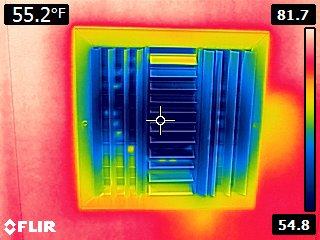 |
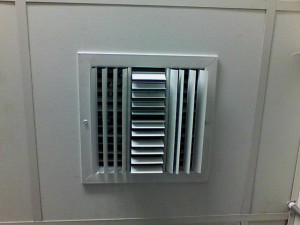 |
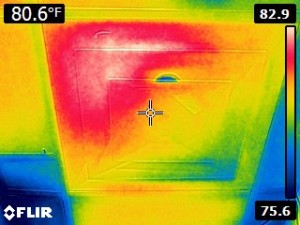 |
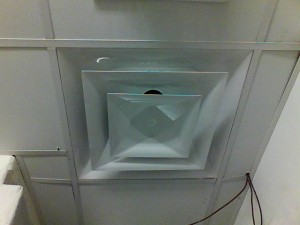 |
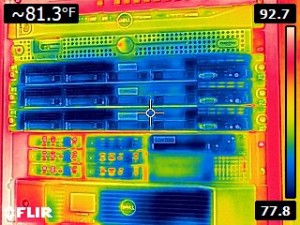 |
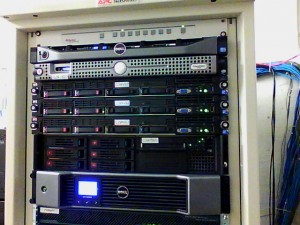 |
 |
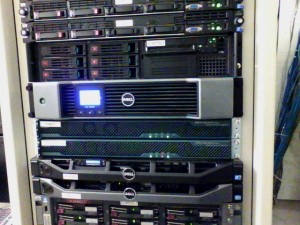 |
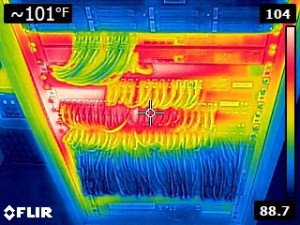 |
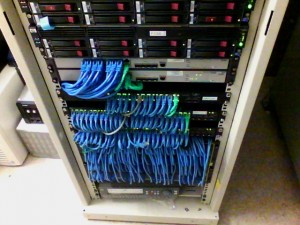 |
Immediately useful is that fact that you can see our two AC ducts were putting out radically different air temperatures. Further you can graphically see the resulting temperatures of our equipment and the hot spots. This lends itself well to resolution by implementing solutions where necessary. Finally as this is a serious tool the results are conclusive and usable as evidence which can help bolster a claim for fixes to the installation that houses our server rack and array. Temperatures shown are less than 0.06 degrees from actual when the device has been properly configured.
These images also clearly demonstrate one of the major advancements in thermal infrared cameras which Flir calls MSX. Plainly put it is the ability of this serveries to merge a standard digital image (what you see on the right) with a thermal image to create a layered thermal image (what you see on the left). This is enormously useful is diagnosis and analysis.
Resolutions and Solution Impact
Everything is about ROI these days. After our server room issue we resolved our AC problem but the question remained “How much impact did it make?” Sure the room was cooler but what is the impact to our equipment and do things actually run cooler? How much cooler? Whats the result? Compare these shots to those on the previous page.
 |
 |
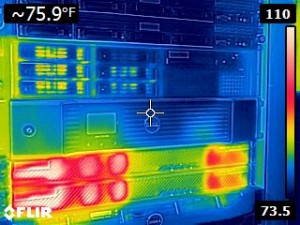 |
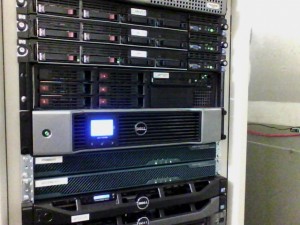 |
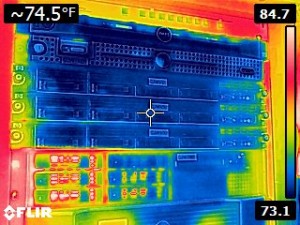 |
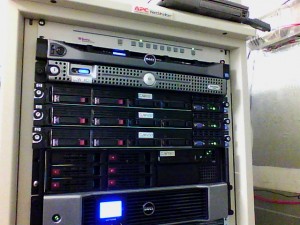 |
 |
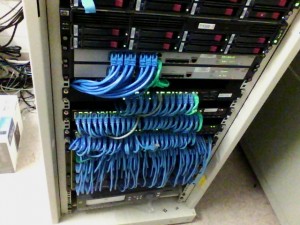 |
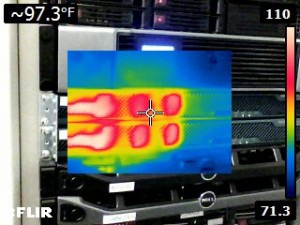 |
 |
As you can see there has been a dramatic drop in operating temperatures of the equipment. Temperature on the wall thermostat reads 62 degrees but the question of how this translates into equipment operating temperature has been answered. Additionally we have identified areas that can use more airflow. These results translate into greater longevity for equipment, lower failure rates on hard drives and servers, and greater operational reliability. Know of any IT Admins that would turn down these benefits? I don’t!
Additional Features
Turning the E6 on and accessing the built in menu’s offers an array of additional features likely to be of value depending upon your intended use. The color modes may be changes to either Iron, Rainbow, Gray, Blue Below, and Red Above as well as adjusting the alignment distance to object for calibration and changing temperature readings from Celsius to Fahrenheit. You can also choose to save photo’s as separate JPEG’s as we did above as well as switching the unit into Picture in Picture mode. On the hardware end of things the battery is the only removable part and may be charged separately through an optional charger or internal using the micro USB adapter via a PC or Mac.
One of the larger features of the Flir cameras is the associated warranty that Flir includes once you register your unit. The unit comes with a 10 year warranty on the detector itself, a 5 year warranty on the battery, and a 2 year warranty on parts and labor. Given the substantial investment made into the detector this additional warranty will leave you with peace of mind about your equipment in case of any failure.
Flir E6 Review Analysis and Conclusion
Investing anywhere from $995 to $5,995 is no small drop of funds for the EX series thermal imagers from Flir. What we have found is a great lineup that offers a good range of features at an relatively affordable price for the features and resolution offered. Flir is not the only entry into this market as Fluke and Milwaukee also have significant offerings. Some of these offerings are as low as ~$500 and available right now. The Flir comes out ahead in several areas including ease of use, range of features, and most importantly warranty. The device takes excellent images with excellent speedy transfer to your computer and is presented in a very professional manner.
 |
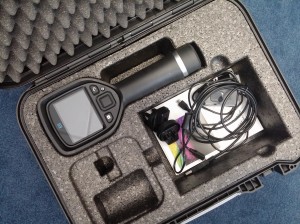 |
The E6 from Flir is a professional tool with an excellent value but it doesn’t come cheap. We highly recommend the E6 to all professionals in need of such a tool for the features and value it brings with it.
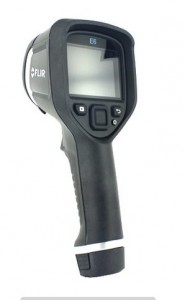





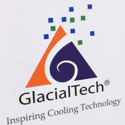
[…] Flir E6 Thermal Infrared Camera @ TechwareLabs […]
[…] Flir E6 Thermal Infrared Camera Review at TechwareLabs.com […]
[…] Flir E6 Thermal Infrared Camera Review @ TechwareLabs.com […]
[…] Flir E6 Thermal Infrared Camera Review @ TechwareLabs.com […]
[…] Flir E6 Thermal Infrared Camera Review @ TechwareLabs.com […]